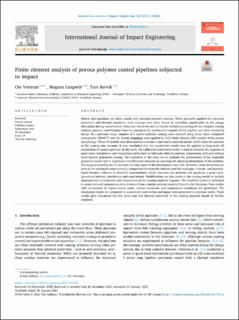| dc.contributor.author | Vestrum, Ole | |
| dc.contributor.author | Langseth, Magnus | |
| dc.contributor.author | Børvik, Tore | |
| dc.date.accessioned | 2021-10-21T07:26:24Z | |
| dc.date.available | 2021-10-21T07:26:24Z | |
| dc.date.created | 2021-02-09T13:52:54Z | |
| dc.date.issued | 2021 | |
| dc.identifier.citation | International Journal of Impact Engineering. 2021, 152, . | en_US |
| dc.identifier.issn | 0734-743X | |
| dc.identifier.uri | https://hdl.handle.net/11250/2824329 | |
| dc.description.abstract | Subsea steel pipelines are often coated with external polymer coatings. While primarily applied for corrosion protection and thermal insulation, such coatings have been shown to contribute significantly to the energy absorption during impact events. However, due to the lack of reliable models accounting for the complex coating features, positive contributions from the coating to the mechanical response of the pipeline are often omitted in design. In a previous study, samples of a typical polymer coating were scanned using X-ray micro computed tomography (XRMCT) and the density mappings were applied to build finite element (FE) models of the porous morphology. These FE models were then used to calibrate a constitutive material model, which takes the porosity of the coating into account. It was concluded that the constitutive model may be applied in large-scale FE simulations of coated pipelines. In this work, the calibrated constitutive model is used to simulate the response of quasi-static indentation and impact tests performed on full-scale offshore pipeline components with and without multi-layered polymeric coating. The objectives of the work are to evaluate the performance of the originally presented model and to implement modifications essential in capturing the physical phenomena of the problem. The original model is seen to describe the early parts of the deformation very well. However, some deviations are seen as the coating becomes severely compressed between the indenter and the steel pipe. A strain- and porosity-based fracture criterion is therefore implemented, which alleviates the problem and produces a good correspondence between simulations and experiments. Modifications are also made to the coating model to include dependencies of strain-rate and temperature in the coating material response. The modified model is calibrated to strain-rate and temperature data retrieved from a similar polymer material found in the literature. Case studies with simulations of impact events under various strain-rate and temperature conditions are performed. The simulation results are compared to quasi-static indentation and impact tests presented in previous works. These results give indications that the strain-rate and thermal sensitivity of the coating material should be further explored. | en_US |
| dc.language.iso | eng | en_US |
| dc.publisher | Elsevier Science | en_US |
| dc.rights | Navngivelse 4.0 Internasjonal | * |
| dc.rights.uri | http://creativecommons.org/licenses/by/4.0/deed.no | * |
| dc.title | Finite element analysis of porous polymer coated pipelines subjected to impact | en_US |
| dc.type | Peer reviewed | en_US |
| dc.type | Journal article | en_US |
| dc.description.version | publishedVersion | en_US |
| dc.source.pagenumber | 16 | en_US |
| dc.source.volume | 152 | en_US |
| dc.source.journal | International Journal of Impact Engineering | en_US |
| dc.identifier.doi | 10.1016/j.ijimpeng.2021.103825 | |
| dc.identifier.cristin | 1888139 | |
| dc.source.articlenumber | 103825 | en_US |
| cristin.ispublished | true | |
| cristin.fulltext | original | |
| cristin.qualitycode | 2 | |

